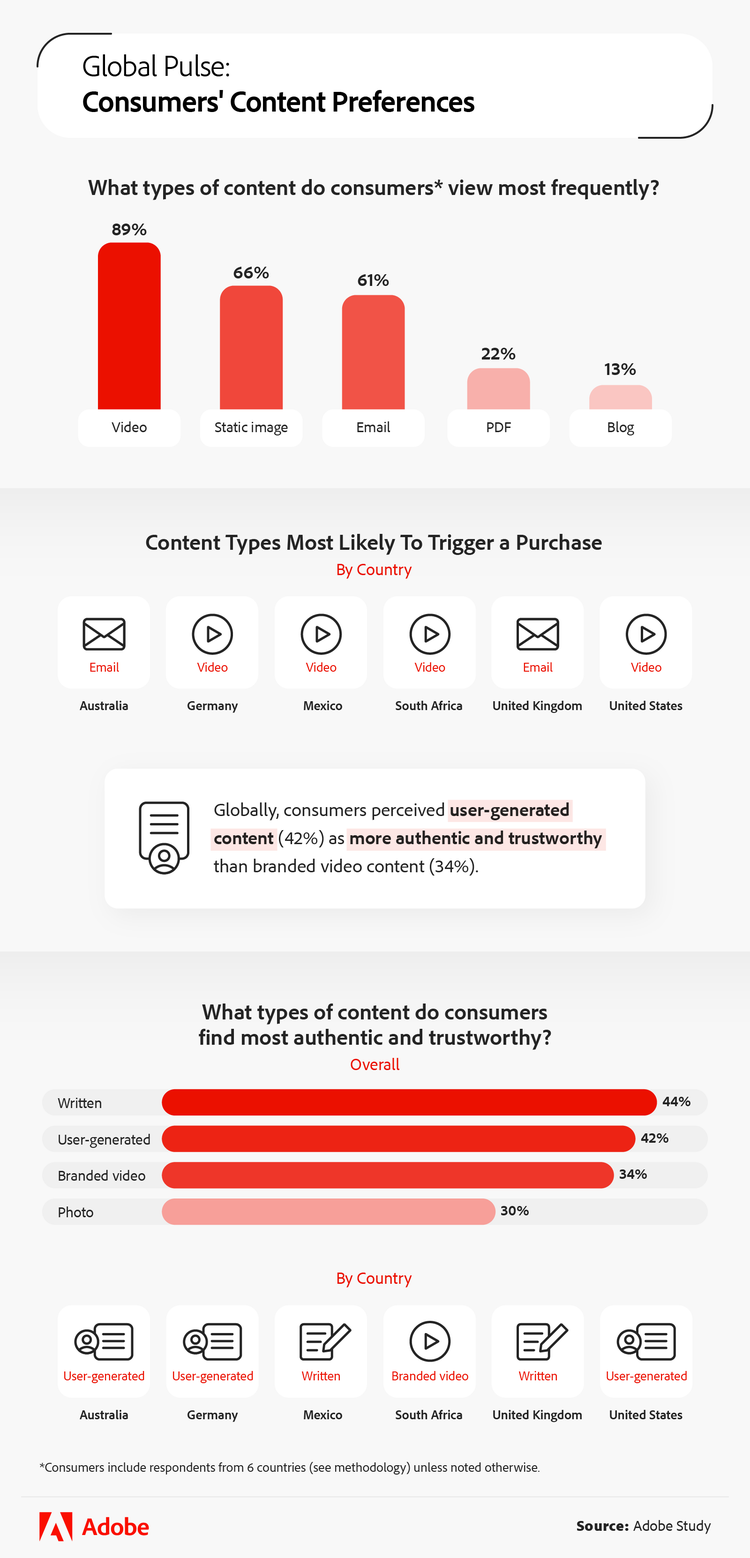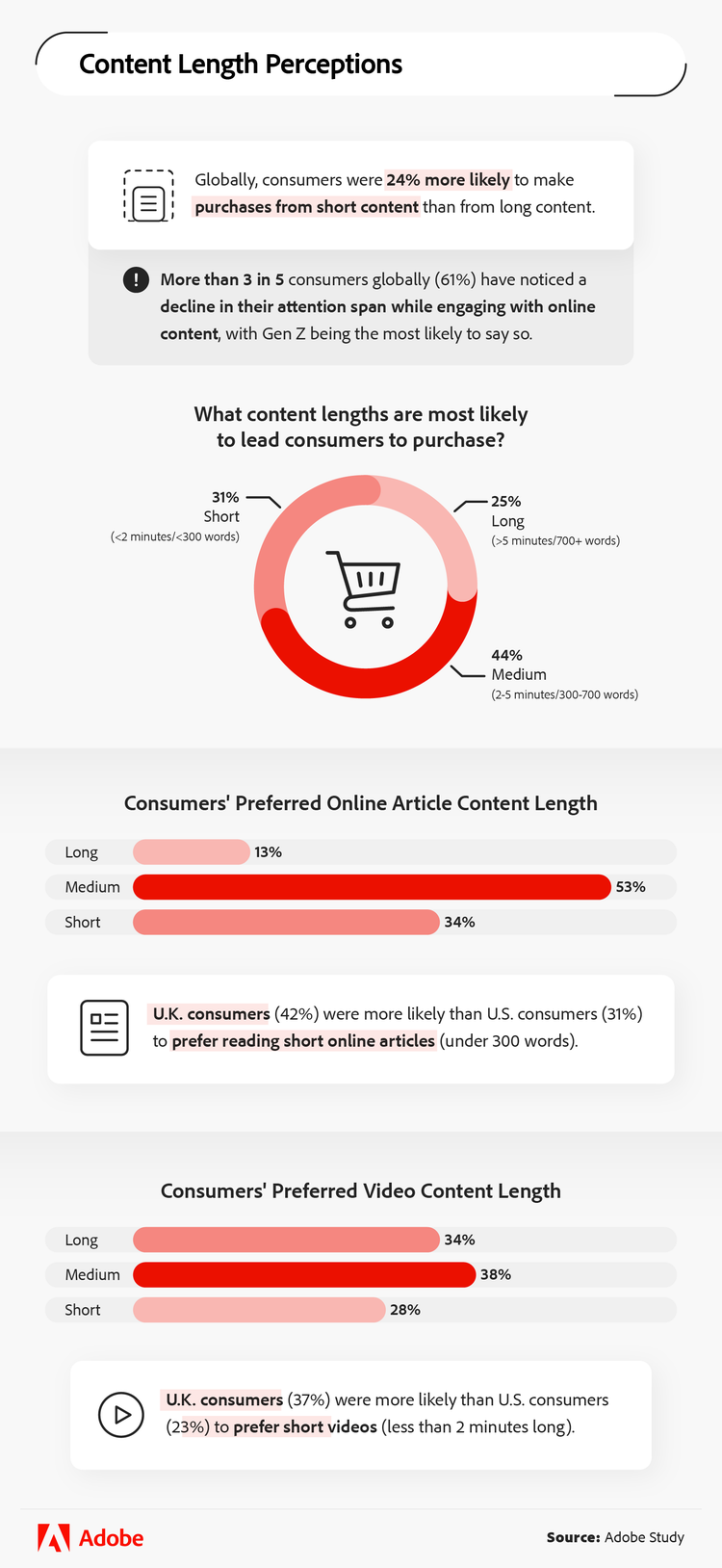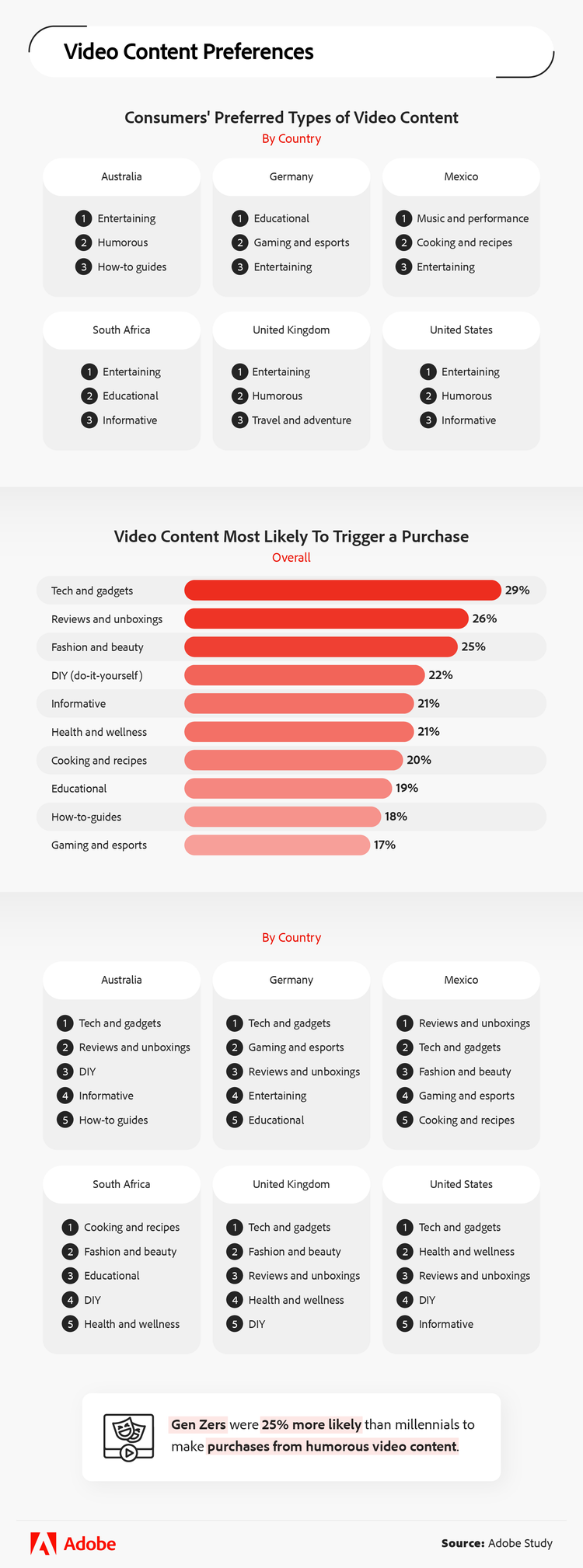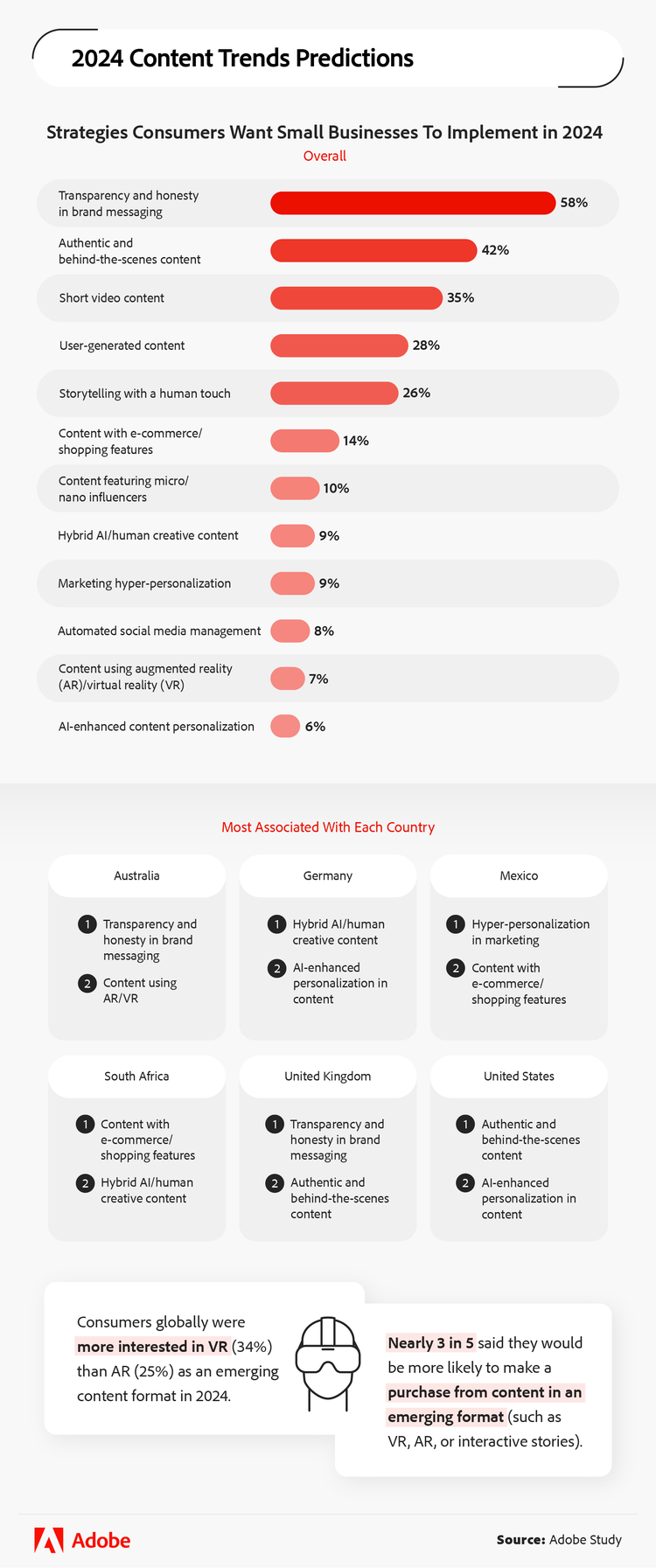Global marketing content trends and preferences

What really grabs people’s attention in the ever-buzzing world of digital content? We surveyed 1,013 consumers from around the globe to find out.
This piece explores how different kinds of content resonate with audiences worldwide and influence purchasing decisions. In addition to looking at what’s trending, we’ll dig into how different generations and regions interact with content. Get ready to gain a deeper understanding of what drives engagement and how consumer behaviors are changing in this fast-paced digital age.
Key takeaways
- Consumers globally (especially Gen Zers) perceive user-generated content as more authentic and trustworthy than branded video content.
- Globally, consumers were 24% more likely to purchase from short content than long content.
- 61% of global consumers say they have shorter attention spans while engaging with online content, and only one in four said long content would lead them to purchase.
- Consumers globally were most likely to make purchases from videos of the following content: tech/gadgets (29%), reviews/unboxings (26%), and fashion/beauty (25%).
- Nearly three in five consumers globally desire more transparency and honesty in brand messaging from small businesses for 2024.
Summary/Overview
The power of authenticity
Beyond products and services, good marketing sells trust in a brand. Here’s what we learned about how to earn customer trust based on our global intergenerational survey. We’ll also see what types of content global consumers consume most.

Gen Zers were the most likely to think user-generated content was the most authentic and trustworthy. These savvy digital natives know how to spot a sales pitch, so marketing to them requires special finesse. Consumers globally shared this sentiment as well, with more of them perceiving user-generated content as authentic and trustworthy (42%) than branded video content (34%).
Gen Z was also the generation most likely to say video was their content of choice (98%). This preference aligned with respondents’ ages, being more prevalent with the younger crowd: 91% of millennials preferred video content as well, followed by 78% of Gen X. Meanwhile, baby boomers report that they are most likely to consume their online content via email (69%), demonstrating that older generations are more inclined to trust written content. This suggests that email marketing is a good strategy for connecting with older generations.
Overall, global consumers believed written content was the most authentic and trustworthy (44%). Fewer said the same of branded videos (34%) and photos (30%) — maybe the rise of influencer marketing on visual content-based online platforms like Instagram has made these types of content feel less authentic.
Although nearly 5 billion people use social media globally, the likelihood of discovering content this way varied across countries. Mexico was at the forefront, with 70% reporting they find new online content via social media platforms. South Africa followed closely at 67%, with the U.K. at 53%, Australia at 52%, Germany at 50%, and the U.S. at 43%. These findings indicate social media’s varying influence on content discovery in different regions.
The best short-form, long-form, and video content
Once we learned global content preferences, we moved on to consumer behavior. How long should different types of marketing content be, and how do length and other characteristics affect purchasing decisions? Let’s see what consumers across generations and countries had to say.

Short-form and long-form content each have their perks: short content (in this study, under two minutes or 300 words) is a fast, effective way to get a brief message across, while long content (over five minutes or 700 words) allows more detail and depth. There’s also medium-form content that runs two to five minutes or is between 300-700 words. So, which results in more conversions? It might depend on what part of the world consumers are in.
Overall, global consumers said medium-length content would be more likely to lead them to purchase (44%) than long (25%) or short content (31%). However, they were 24% more likely to make purchases from short content than from long content, especially South Africans (39%). Mexican consumers went the opposite way: they were 34% more likely to purchase from long versus short content.
Global preferences also leaned toward short content for social media post captions (84%). Similarly, long content might be the least effective way to convert U.K. audiences. These respondents were the least likely to make purchases from long content (19%) and the most likely to purchase based on medium-length content (47%).
Social media users in the U.K. and the U.S. may share similar behaviors on these apps, but we found that short content was more likely to lead U.K. consumers to purchase (34%) than U.S. consumers (26%). However, they agreed on one thing: they felt their attention spans were shorter when interacting with online content (63% and 47%, respectively). The broader range of global consumers we surveyed said the same (61%).
Interactive content includes elements like polls and quizzes — two things that only half of our global respondents said were important aspects of “engaging” content. This suggests that, although interactive elements like these are intended to hold users’ attention, they may not do the trick for everyone.

A marketing video can be a great way to tell your audience about a product or service, depending on which category it falls under. Consumers worldwide were most likely to make purchases influenced by videos featuring technology and gadgets (29%). Product reviews and unboxing videos followed closely, influencing 26% of consumers to purchase, while 25% said the same about fashion and beauty content.
Gen Z may be driving these global trends, as they were the generation most likely to purchase from videos featuring all the product types above: tech, gadgets, fashion, and beauty.
Tech and gadget video content appeared to have the most global appeal among the countries we studied. These videos greatly impacted purchasing decisions among consumers in Australia, Germany, the U.K., and the U.S. Meanwhile, reviews and unboxings led to the most conversions in Mexico, and South Africa made the most purchases from cooking and recipe videos. Globally, baby boomers were more likely to have been influenced by videos about health and wellness or informational content.
Forecasting the future
Next, we’ll share what our survey told us about what global consumers want to see in brand messaging and marketing content in 2024.

Most consumers globally (85%) noted the importance of sustainability in brand strategy. By country, this was expressed most by consumers in South Africa (97%), Mexico (92%), Australia (87%), Germany (86%), the U.K. (82%), and the U.S. (75%).
Since brand transparency and sustainability go hand in hand, that could be a good thing for brands to focus on in the coming year. Nearly 3 in 5 consumers globally expressed a desire for more transparency and honesty in brand messaging, especially from small businesses, in 2024.
As for what that content should look like, consider using up-and-coming technology. Millennials, in particular, were interested in seeing new, emerging content formats in 2024, including virtual reality (VR), augmented reality (AR), or interactive stories.
Wondering if it will be worth it? It may depend on who your target market is. Gen Z was 19% more likely than millennials to say they’d purchase through these innovative formats. In addition, nearly three in 10 Gen Zers were excited about the prospect of interactive stories, especially things like Instagram’s new “hype” comment option.
The future of digital content
Our study highlights the growing influence of user-generated content in marketing, the varied effects of different video formats on consumers, and the rising importance of sustainability in brand communication. These insights can help content creators and marketers craft strategies that connect with a broad and ever-changing global audience. As we move forward, applying these insights in creating content that is both engaging and authentic will be essential in connecting with consumers around the world.
Methodology
For this campaign, we conducted a global survey with 1,013 participants from various countries to gain insights into marketing content preferences, perceptions, and trends worldwide. The respondents were distributed as follows:
- 25% from the United States
- 25% from the United Kingdom
- 13% from Australia
- 13% from South Africa
- 12% from Mexico
- 12% from Germany
In terms of generations, the breakdown is as follows:
- Gen Z: 24%
- Millennials 54%
- Gen X: 15%
- Baby boomers: 7%
Fair use statement
Interested in the dynamics of global content trends and consumer preferences? You’re welcome to share the insights from this study for any non-commercial purpose. We just ask that you link back to this page, ensuring your audience can access the full range of findings and understand the comprehensive methodology behind them.